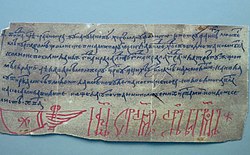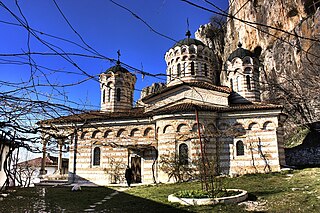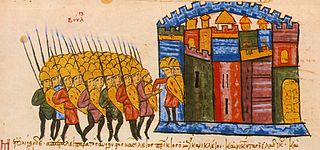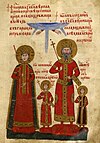
The Hilandar Monastery is one of the twenty Eastern Orthodox monasteries in Mount Athos in Greece and the only Serbian monastery there. It was founded in 1198 by Stefan Nemanja and his son Saint Sava. St. Symeon was the former Grand Prince of Serbia (1166–1196) who upon relinquishing his throne took monastic vows and became an ordinary monk. He joined his son Saint Sava who was already in Mount Athos and who later became the first Archbishop of Serbia. Upon its foundation, the monastery became a focal point of the Serbian religious and cultural life, as well as assumed the role of "the first Serbian university". It is ranked fourth in the Athonite hierarchy of 20 sovereign monasteries. The Mother of God through her Icon of the Three Hands (Trojeručica) is considered the monastery's abbess.

The Monastery of Saint John of Rila, also known as Rila Monastery "Sveti Ivan Rilski", is the largest and most famous Eastern Orthodox monastery in Bulgaria. It is situated in the southwestern Rila Mountains, 117 km (73 mi) south of the capital Sofia in the deep valley of the Rilska River at an elevation of 1,147 m (3,763 ft) above sea level, inside of Rila Monastery Nature Park. The monastery is named after its founder, the hermit Ivan of Rila, and houses around 60 monks.
Ivan Sratsimir, or Ivan Stratsimir, was emperor (tsar) of Bulgaria in Vidin from 1356 to 1396. He was born in 1324 or 1325, and he died in or after 1397. Despite being the eldest surviving son of Ivan Alexander, Ivan Sratsimir was disinherited in favour of his half-brother Ivan Shishman and proclaimed himself emperor in Vidin. When the Hungarians attacked and occupied his domains, he received assistance from his father and the invaders were driven away.

Ivan Shishman ruled as emperor (tsar) of Bulgaria in Tarnovo from 1371 to 3 June 1395. The authority of Ivan Shishman was limited to the central parts of the Bulgarian Empire.

Ivan Alexander, also sometimes Anglicized as John Alexander, ruled as Emperor (Tsar) of Bulgaria from 1331 to 1371, during the Second Bulgarian Empire. The date of his birth is unknown. He died on 17 February 1371. The long reign of Ivan Alexander is considered a transitional period in Bulgarian medieval history. Ivan Alexander began his rule by dealing with internal problems and external threats from Bulgaria's neighbours, the Byzantine Empire and Serbia, as well as leading his empire into a period of economic recovery and cultural and religious renaissance.

The Second Bulgarian Empire was a medieval Bulgarian state that existed between 1185 and 1396. A successor to the First Bulgarian Empire, it reached the peak of its power under Tsars Kaloyan and Ivan Asen II before gradually being conquered by the Ottomans in the late 14th century.

Saint Paisius of Hilendar or Paìsiy Hilendàrski (1722–1773) was a Bulgarian clergyman and a key Bulgarian National Revival figure. He is most famous for being the author of Istoriya Slavyanobolgarskaya (1762), the first significant modern Bulgarian history that became famous and has been copied and distributed everywhere in the Bulgarian lands. The book is overall third modern Bulgarian history after the works titled "History of Bulgaria" by Petar Bogdan Bakshev in 1667 and by Blasius Kleiner in 1761. He is considered the forefather of the Bulgarian National Revival.

The Saint George the Zograf Monastery or Zograf Monastery is one of the twenty Eastern Orthodox monasteries in Mount Athos in Greece. It was founded in the late 9th or early 10th century by three Bulgarians from Ohrid and is regarded as the historical Bulgarian monastery on Mount Athos, and is traditionally inhabited by Bulgarian Orthodox monks.

Fruzhin was a 15th-century Bulgarian noble who fought actively against the Ottoman conquest of the Second Bulgarian Empire. A son of one of the last Bulgarian tsars, Ivan Shishman of the Tarnovo Tsardom, Fruzhin co-organized the so-called Uprising of Konstantin and Fruzhin along with Constantine II of Vidin, the last Bulgarian monarchs. Fruzhin was mainly based in the Kingdom of Hungary, where he was the ruler of Temes County.

The Tsardom of Vidin was a medieval Bulgarian state centred in the city of Vidin from 1356 to 1396.
Dorothea of Bulgaria, also called Doroslava, was the first Queen of Bosnia. Daughter of the Bulgarian tsar Ivan Sratsimir, Dorothea was held hostage by King Louis I of Hungary, who married her off to Ban Tvrtko I of Bosnia in 1374. She became queen in 1377 and may have been the mother of King Tvrtko II.

Dragalevtsi Monastery of the Holy Mother of God of Vitosha is a Bulgarian Orthodox monastery on the lower slopes of Vitosha mountain on the outskirts of the capital Sofia in western Bulgaria. Founded in the mid-14th century by Bulgarian tsar Ivan Alexander, the monastery was abandoned after the Ottoman conquest of Sofia and reestablished in the late 15th century, when it became an important literary centre. The monastery church and some of its frescoes date from this period.

The Peshtera Monastery of Saint Nicholas of Myra, also known as the Mraka Monastery or Oryahov Monastery is a medieval Eastern Orthodox monastery in western Bulgaria, located in the Mraka area at the village of Peshtera, near Zemen, Pernik Province. As of 2008, the monastery is not operative.

Hrelja also known as Protosebastos Hrelija, also known as Stefan Dragovol or Hrelja Ohmućević was a 14th-century semi-independent feudal lord in the region of northeastern Macedonia and the Rila mountains who served medieval Serbian kings Stefan Milutin, Stefan Dečanski and Stefan Dušan. He became independent autocrat with vast political autonomy and capital at Strumica, formally recognizing Byzantine authority.

Doleni is a village in the municipality of Sandanski, in Blagoevgrad Province, south-western Bulgaria and as of 2013 has only 3 inhabitants. It is situated at the south-western foothills of the Pirin mountains a few kilometres north of the Melnik Earth Pyramids. Further north is located Pirin National Park, a UNESCO World Heritage Site. Doleni lies some 124 km south of the national capital Sofia.
John Komnenos Asen was the ruler of the Principality of Valona from c. 1345 to 1363, initially as a vassal of the Serbian Empire, and after 1355 as a largely independent lord. Descended from high-ranking Bulgarian nobility, John was a brother of both Tsar Ivan Alexander of Bulgaria and Helena of Bulgaria, the wife of Tsar Stephen Dušan of Serbia. Perhaps in search of better opportunities, he emigrated to Serbia, where his sister was married. There, he was granted the title of despot by Stephen Dušan, who placed him in charge of his territories in modern south Albania.
This is a list of people, places, and events related to the medieval Bulgarian Empires — the First Bulgarian Empire (681–1018), and the Second Bulgarian Empire (1185–1396).
Spiridon Gabrovski, also known as Spiridon Rilski, was a Bulgarian clergyman and activist of the Bulgarian National Awakening in the Ottoman Empire.






















